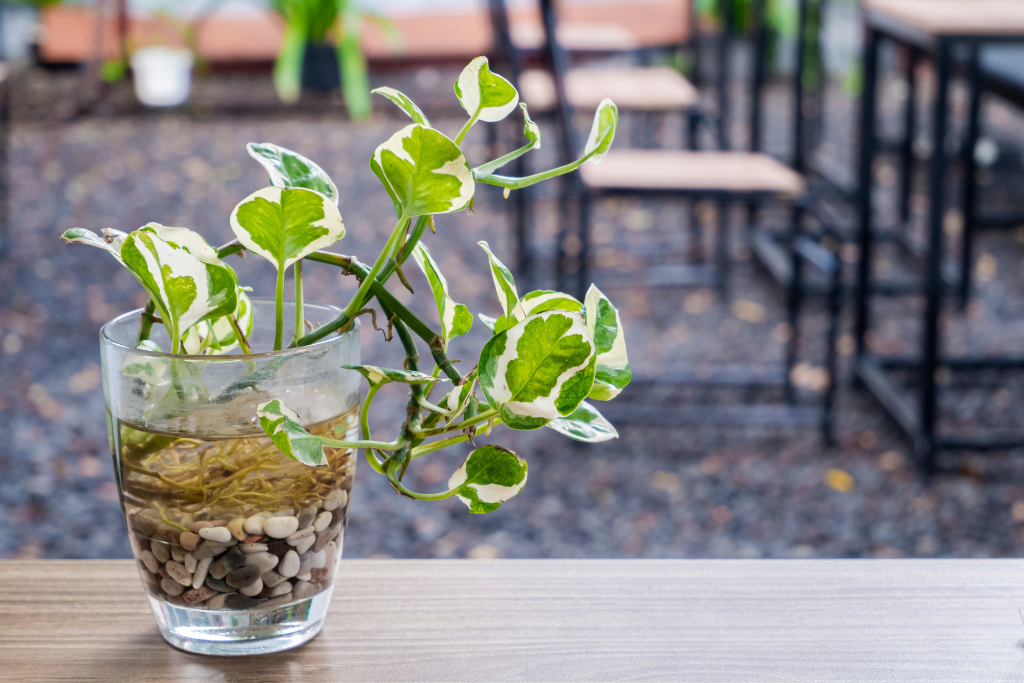The Begonia maculata, commonly known as the Polka Dot Begonia or the Trout Begonia, is a gorgeous houseplant which is quite popular amongst indoor gardening enthusiasts. It has striking and beautiful leaves, deeply adorned with silver spots and accompanied by a lively deep green color. This variety of begonia adds a sense of elegance and beauty to your living spaces.
To make sure that your Begonia maculata grows well, stays healthy and lives for a long time, it’s vital to make sure that you understand how to use the correct care techniques for them. In this comprehensive article, we’ll delve deep into the aspects of caring for one of these plants, and the ideal growing conditions while including watering, fertilizing, pest management, propagation and more.

Understanding Begonia maculata
Features and Description
The Polka Dot Begonia has asymmetrical and obliquely shaped leaves, which are a glossy green and have silver-white spots. A fun fact – the common name Trout Begonia comes from the fact that the unique markings resemble those patterns found on a trout fish, hence giving it the name Trout Begonia! I wouldn’t try and catch a plant with your fishing rod though…
This particular variety of Begonia is a rhizomatous perennial, growing upright and eventually reaching heights of one to two feet (or 30-60cm). The stems on these plants are typically cane-like, producing beautiful clusters of flowers. These flowers will be produced in favorable conditions, and they are normally pink or white blossoms found on tall stems – a beautiful sight to see.
The Ideal Growing Conditions
Lighting is one of the most important aspects of keeping any plant alive, and the Begonia maculata will thrive in indirect and bright light. It’s best to avoid exposing it to direct sunlight, as this can scorch the leaves and damage the plant.
Temperature is another important factor in keeping your Begonia maculata alive. They prefer temperatures between 65-75F (18-24C) during the day while preferring slightly cooler temperatures at night. You should aim to protect the plant from drafts and any temperature extremes, so keep it away from air conditioning units or windows/doors that are opened frequently.
The majority of houseplants love humidity, and the Polka Dot begonia is no exception. This begonia variety thrives in moderately high humidity levels, which is around fifty to sixty percent. There are many ways to increase humidity, such as using a humidifier, placing the plant on a pebble tray filled with water, grouping it with other plants to form a microclimate or frequently misting.
Soil is an important part of the health of your plants, and if they are potted in an unsuitable mix, they will likely suffer. You should opt to use a well-draining potting mix instead, which will retain moisture without becoming waterlogged which could damage the roots and cause root rot. A mixture of peat moss, perlite and a small amount of organic matter such as compost would be best for this. Ideally, the soil pH should be slightly acidic to neutral, which ranges from around 6.0 – 7.0.
Watering and Managing Moisture

Watering Technique
Getting the timing correct for watering is essential. You don’t want to overwater or underwater your plants, so you need to strike a balance. Water your begonia when the top inch (2.5cm) of the soil feels dry to the touch. You should stick your finger in the soil to check the moisture level before watering. If it’s still saturated, avoid watering it until it dries out a bit more.
Although most houseplants aren’t too sensitive to the chemicals in water, the Begonia maculata is. It prefers water free from chemicals and minerals, so if possible, you should use filtered or distilled water. If tap water is your only option, it would be best to let it stand for 24 hours to allow any chlorine to dissipate.
You’ll find that as the seasons change, so will how often you have to water your plants. During the active growth period in spring and summer, the plant will be actively producing new foliage and flowers, meaning that you’ll have to water the plant more frequently. When it gets to the dormant period in autumn and winter, you should reduce the frequency of watering but never let the soil completely dry out.
When you water your begonia, make sure that you thoroughly saturate the soil, ensuring that water drains out from the bottom of the pot. If you are keeping the pot in a saucer, empty the saucer after watering it to make sure the plant doesn’t sit in standing water. Standing water can promote the growth of nasty bacteria, which can cause problems for your plant.
Humidity Management
The Polka Dot begonia will appreciate higher humidity levels, so make sure that you mist the leaves regularly using a spray bottle filled with water to increase humidity around the plant. Try to avoid misting the flowers as this can damage them – focus more on the foliage.
Another way to increase humidity is by placing the pot on a tray filled with water and pebbles. As the water evaporates, this will increase the humidity around the plant. Make sure that the pot isn’t sitting directly in the water though, as this can lead to root rot.
Grouping plants is an effective and free way of increasing the humidity around your plant. You can group your begonia with other houseplants to create a microclimate, raising humidity levels. As the plants transpire, they will release moisture into the air, increasing the humidity for each other.
Fertilization and Nutrient Requirements
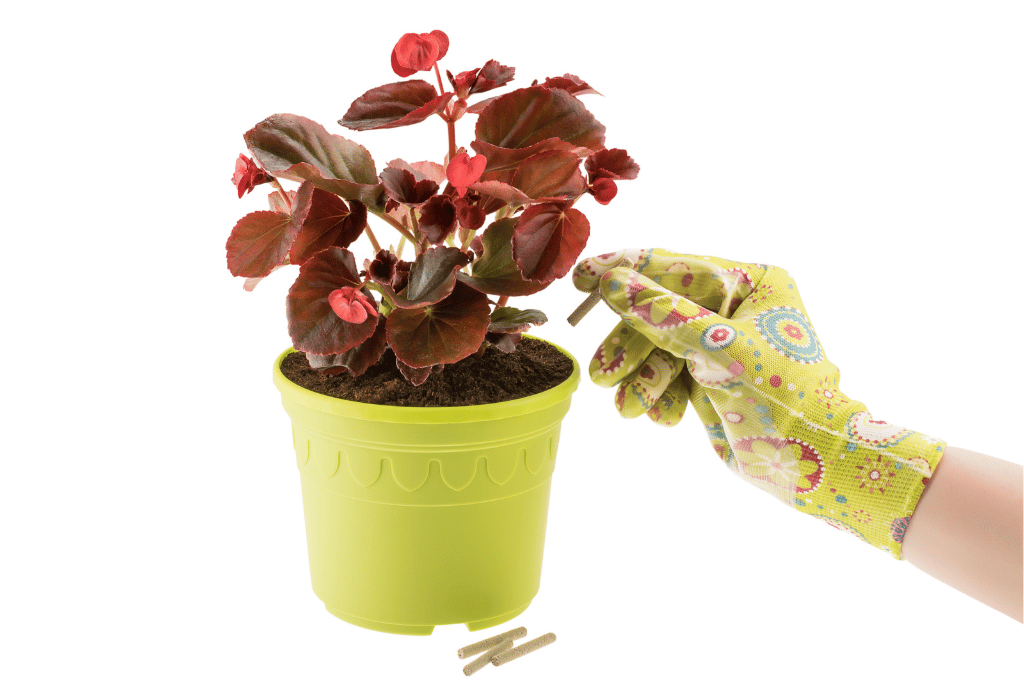
Choosing The Right Fertilizer
Typically, a balanced fertilizer will be the best choice for your houseplants. These should be water-soluble fertilizers with high NPK ratios, providing a balanced mix of nitrogen (N), phosphorus (P) and potassium (K) which are necessary macronutrients for overall plant health and growth. If you prefer organic options, you could use diluted fish emulsion as a natural fertilizer for Begonia maculata. Make sure that you follow the package instructions and follow the application rates so that you don’t overfertilize and burn the roots of your plant.
Fertilizing Schedule
During the active growth period in spring and summer when the plant is producing new foliage and flowers, it would be best to fertilize every two to four weeks. Dilute the fertilizer to half or quarter strength to make sure that you don’t overfeed. When it gets to autumn and winter and the plant enters a rest period, make sure that you reduce or completely halt fertilization. The plant’s growth will slow down, and it won’t require as many nutrients.
Propagation Techniques
As I always say, propagation is a vital skill to have when taking care of plants. It allows you to get completely new plants for pretty much free – just the cost of a pot, soil and some time. You can give away those free plants to friends and family, or even sell them and fund your plant addiction.
Stem Cutting Propagation
Stem cuttings are perhaps the most successful, viable and easy ways of propagating many plants. Let’s go through how to do it:
- Select a cutting. Choose a healthy stem with several nodes, making sure that it’s free from pests and disease. The stems should be firm and not overly elongated (leggy).
- Prepare the cutting. Using clean and sharp scissors or pruning shears, make a clean cut just below a node (where the leaves emerge from). Then, remove any of the lower leaves, leaving only a few leaves at the top. This will help to reduce the stress on any newly formed roots and reduce water loss through transpiration.
- Fill a small pot or container with a good, well-draining rooting medium. A mixture of peat moss, perlite or a specialized mixture made for cuttings will work well. Moisten the medium slightly, ensuring that there is good contact with the cutting.
- This is an optional step. You can dip the cut end of the stem into a rooting hormone powder or gel, which may help to stimulate root development but this is not necessary for Begonia maculata.
- Now, you should make a small hole in the rooting medium of your choice with a pencil or finger, gently inserting the cutting. Then, firm the medium around the base of the stem to provide stability and to make sure it doesn’t fall out when watering.
- Place the cutting into a warm and humid environment with bright and indirect light. A propagation tray with a clear plastic cover or a makeshift greenhouse using something like a clear plastic food bag will help to create a suitable environment. Mist the cutting regularly, making sure that high humidity is maintained and the medium stays slightly moist.
- After a few weeks, the cutting should develop roots. To check for any roots, you can gently tug on the stem. If there is resistance, it’s likely that roots have formed. Once these roots have got a bit more established, you can then transplant the cutting into a pot with a standard potting mix, following the regular care guidelines for mature plants. If you do fertilize the cuttings though, dilute them heavily as newly formed roots can be sensitive.
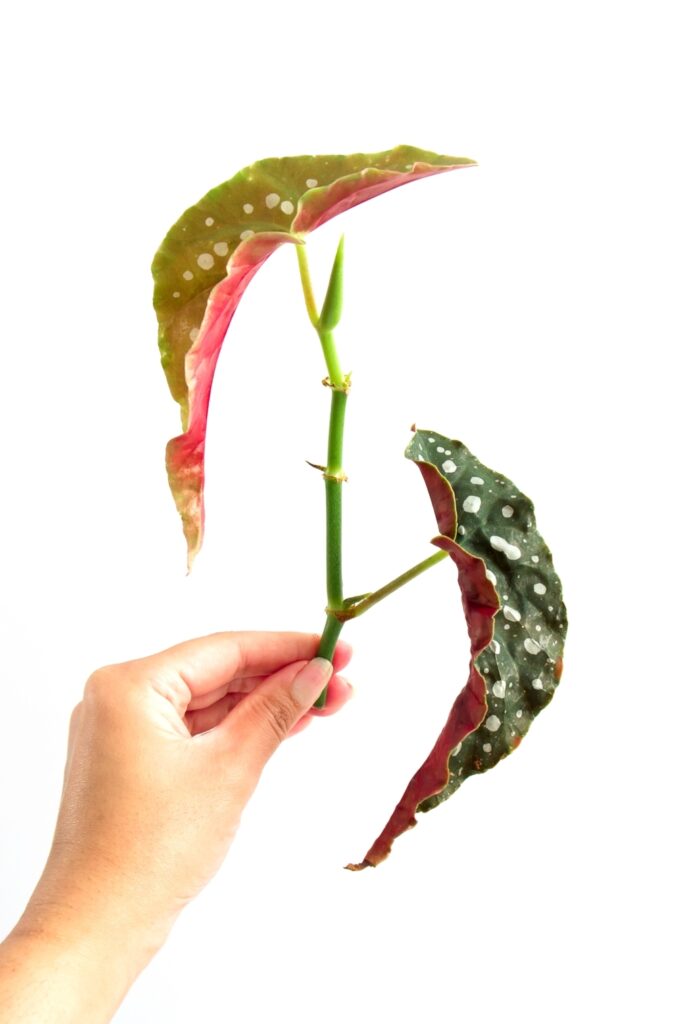
Division Propagation
Propagation by division is another method of propagation, yet it only works for some plants. Luckily, the Polka Dot begonia is one that it does work for. It involves splitting the root ball and stems into separate parts, which become their own separate plants.
- Choose a mature plant. You should select a well-established Begonia maculata which has several healthy stems with a good and full root system.
- Dividing the plant. Carefully remove the plant from the pot, making sure that you are gentle with the roots. Tease apart the rhizomes gently, ensuring that each division has healthy roots and stems.
- Potting the divisions. Prepare individual pots with fresh potting mix, placing each division into its own pot and ensuring the roots are spread out. Fill the pot with the mix, firming it down gently around the plant and ensuring it is stable.
- Watering and aftercare. Water the divisions thoroughly after they have been potted, continuing with regular care. Follow the watering and fertilizing guidelines as mentioned previously.
Common Pests and Diseases
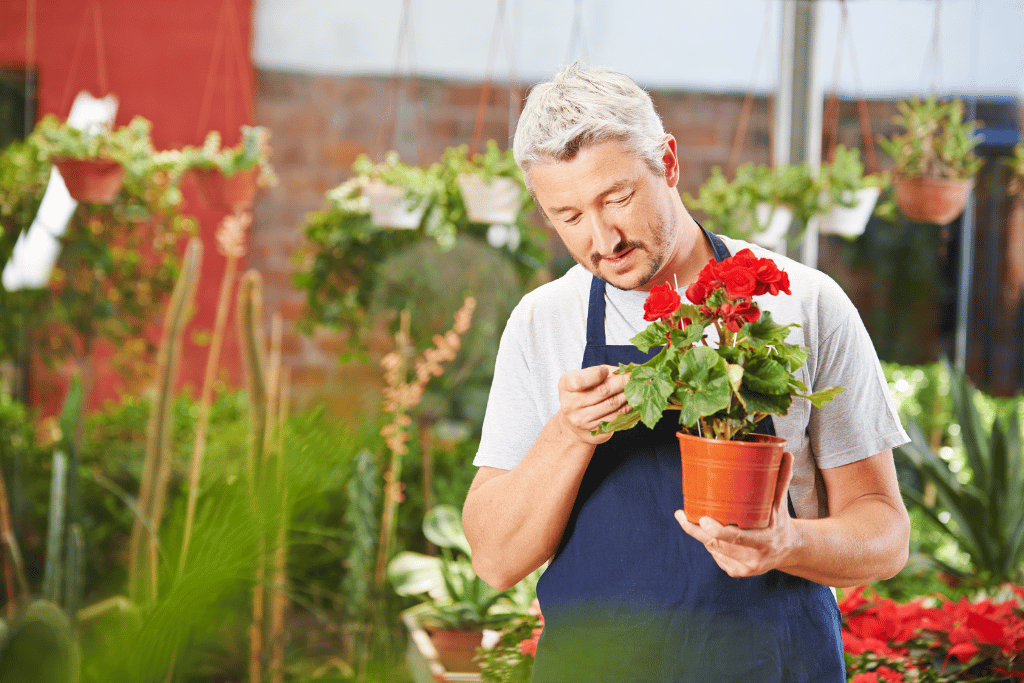
Unfortunately, pests and diseases are common problems on many houseplants that we have to look out for regularly. I would recommend checking over your plants regularly to stop any infestations as soon as possible, which will help to prevent the problem from getting out of hand. You will also get an understanding of how your plant normally is, meaning that you’ll be able to notice any small differences which could be problem signs.
Pests
Spider mites are tiny pests which are common indoor plant pests, and they can affect begonias. They will spin webs over your plant and cause yellowing leaves, leading to an overall plant decline. You can treat spider mites by washing the plant with a strong jet of water, applying insecticidal soap, or using natural predators such as ladybugs. I like to use neem oil, which is organic and particularly effective.
Mealybugs are small insects which look like white, cotton-like masses on the stems and leaves of your plant. They suck sap from the plant, which can cause yellowing leaves and weak growth. You can remove mealybugs manually with cotton swabs dipped in rubbing alcohol or use insecticidal soap.
One of the most common pests, aphids are small insects that cluster on the undersides of leaves. They suck sap and cause distorted growth. You can get rid of them by using a strong jet of water, applying insecticidal soap, or introducing natural predators like lacewings and ladybugs.
Thrips are slender insects that will damage flowers and leaves by feeding on plant tissue. You’ll notice that they leave behind silvery streaks on the foliage from where they’ve been. Use neem oil or insecticidal soap to control thrips.
Diseases
Diseases can be a bit scarier than pests to deal with, as they will likely take longer to treat and you may not have the supplies on hand to deal with them immediately or in an appropriate time frame. This is why it’s best to monitor your plant frequently to check for any problem signs, such as yellowing or browning leaves or unsightly growth. Most diseases that affect begonias are either fungal or bacterial.
Powdery mildew is the first disease that I ever ran into, and it was quite confusing at first. Though, it’s one of the easier diseases to treat. Powdery mildew is a fungal infection, which manifests as a powdery white coating on stems and leaves. It will thrive in humid conditions, and it should be controlled by improving air circulation, avoiding overhead watering and applying fungicides when necessary. If you overwinter plants in places like garages or sheds, make sure that you regularly vent them to improve air circulation and prevent fungal diseases from popping up.
Rhizome rot is a fungal or bacterial infection which will affect the rhizomes of the plant, leading to decay. The most common cause of this is due to overwatering or poorly draining soil, so to prevent rhizome rot, make sure that the soil has good drainage, avoid overwatering and use a well-draining potting mix. If the signs keep on reappearing, remove any affected parts and repot the plant in fresh soil.
Botrytis blight, alternatively known as gray mold, is a fungal disease which causes brown spots and the rotting of stems and leaves. It thrives in cool and damp conditions. Any parts of the plant affected by the blight should be removed. Improve air circulation and avoid overwatering to prevent the spread of the disease.
When you do notice signs of disease or pests on any of your plants, you should make sure that you quarantine the plant immediately. This will help to prevent the spread to other plants, saving you a lot of time, worrying, plant health and money.
Pruning Begonia Maculata
Pruning is an essential part of keeping plants looking alive and well. Pruning will help to control the size and shape of your plants, making sure that your begonia remains compact and bushy. Over time, the lower leaves of the plants may start to drop, which will result in leggy growth. Pruning is a good fix to this, and it will help to remove bare stems, encouraging new growth to form from the base of the plant. Moreover, pruning will help to improve air circulation around the plant, helping to reduce the risk of fungal disease.

Pruning Technique
Pruning is best done in the spring or early summer when the plant is actively growing. Before pruning, you should make sure that you sterilize your pruning tools with rubbing alcohol or a mixture of water and bleach. This will help to prevent the spread of any diseases or pests between plants.
Identify any leggy stems that lack foliage, making clean cuts just above a leaf node or bud. This will encourage new growth from the base, which should be a lot more compact. To promote bushier growth, you can pinch back the tips of the stems. Use your fingers or pruners, and remove just the top few inches of the stem above a leaf node. Remove any dead, diseased or damaged leaves, stems or flowers. Cut them back to healthy tissue, making sure that the cuts are clean.
Pruning Aftercare
After you have pruned your Polka Dot begonia, you should water the plant thoroughly to make sure that any remaining foliage and stems receive good amounts of hydration. Resume regular fertilization after pruning, which will help to support recovery and new growth.
If you have had to do significant pruning, you should adjust the lighting and humidity levels for your plant to make sure that you don’t stress it out and promote healthy regrowth. After pruning, it may take some time for the plant to recover and produce new growth, so it’s best to be patient and provide proper and consistent care.
It’s essential to note that you shouldn’t over-prune Begonia maculata, as significant removal of foliage can weaken the plant. You should aim to maintain a balanced structure, allowing the plant to retain enough leaves for photosynthesis and energy production.
Potting Begonia Maculata
After a few years of growth, you’ll notice that the growth on your begonia may start to slow down, or other worrying signs such as yellowing leaves will start to occur. This may be due to the fact that your begonia is likely root-bound. To fix this, you’ll have to give it a slightly larger pot with room for the roots to grow into.

Choosing The Right Pot
In terms of size, you should select a pot which will allow for good root growth and development. A pot that is around 1-2 inches (2.5-5cm) larger in diameter than the current pot you are keeping it in will generally be suitable. Make sure that the pot has adequate drainage holes at the bottom, which will prevent waterlogging and promote healthy conditions for the roots. Ideally, you should use pots made of materials such as plastic, ceramic or terracotta. Each material will have its own advantages, though terracotta is often preferred as it will provide better airflow and allow moisture to evaporate from the pot easier.
The Potting Procedure
Ideally, you should place a small piece of mesh or a few stones over the drainage holes to prevent soil from escaping while still allowing water to drain freely. Fill the pot with a well-draining potting mix suitable for begonias, such as a mix of perlite, peat moss and small amounts of organic matter such as compost.
Gently remove the begonia from its current pot, making sure that you don’t damage the roots. If the root ball is tightly wound as it has been in there for some time, you can loosen it slightly with your fingers or with something like a chopstick. Place the plant into its new pot, making sure that it sits in the center. If needed, you can adjust the potting mix to make sure it’s aligned well.
Fill any remaining space left around the root ball with the potting mix, gently firming it in to make sure the roots have good contact with the soil. Leave a small gap between the soil surface and the pot rim, which will allow you to water the plant without it overflowing.
After potting, water the plant thoroughly to settle the soil and make sure the roots are touching the soil. Water the plant until it drains out of the bottom, emptying the saucer to avoid water accumulation.
Popular Varieties of Begonia maculata
There are many different varieties of begonia you can get, and they all have their own different characteristics and beautiful patterns. Let’s go over a few so you can pick which one you like the most.
‘Wightii’

This variety has dark green leaves with silver spots and a red undersurface, giving it a lovely and striking appearance. ‘Wightii’ is known for its larger leaves compared to the standard Begonia maculata, making it an eye-catching addition to indoor gardens. It has similar care requirements to the species, including bright indirect light, well-draining soil and good amounts of humidity.
‘Tamaya’
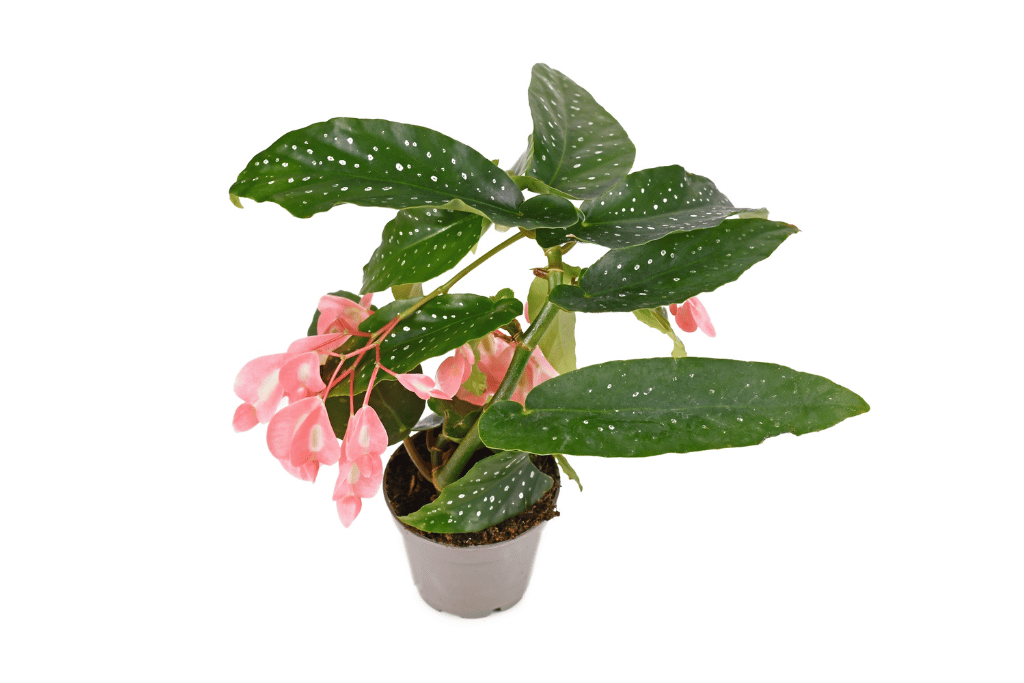
‘Tamaya’ is a cultivar of Begonia maculata which displays distinct silver spots on its leaves, similar to the species. It has a compact growth habit which it is admired for, making it suitable in small pieces or as a table centerpiece. They require the same care as the species.
‘Escargot’
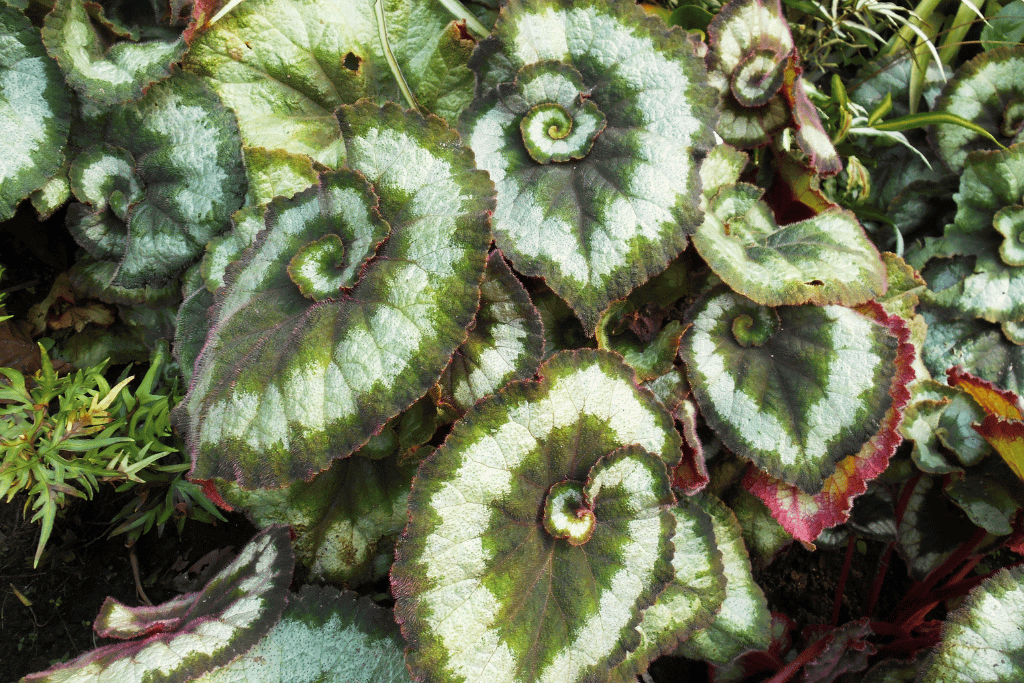
If you know French, then you’ll know what this translates to! The ‘Escargot’ variety of Begonia maculata is known for its unique spiral-shaped leaves, which resemble the shell of a snail. The foliage is a silver-green color with dark green markings and red undersides, adding a bit of pop to any indoor setting. ‘Escargot’ prefers bright and indirect light, moderate humidity and well-draining soil – similar to the care requirements of the species.
‘Freddie’
Freddie’ is a compact variety, ideal for small spaces or as a hanging plant. It features dark green leaves with silver spots and a red underside, maintaining the striking aesthetic of the species. It requires the same care as the species.
‘Curly Red’

This is quite a unique variety of Begonia maculata, with deeply curled leaves and vibrant red undersides. The leaves have the characteristic silver spots of the species, but they have wavy edges too which add a bit of interest. They will thrive given the same conditions as the species.
If you’d like to find more varieties of begonia, you should look around in local nurseries, online plant nurseries and people who grow lots of begonia. Why not expand your collection? From the larger-leaved ‘Wightii’ to the compact ‘Tamaya’, the spiral-shaped ‘Escargot’, the compact ‘Freddie’ and the unique ‘Curly Red’, each variety presents its own interesting features and has a visual appeal. While caring for these varieties, make sure that they receive appropriate light, humidity and watering to support their growth and display any distinctive foliage patterns they may have.
Final Thoughts
With its exquisite foliage and charming flowers, the Begonia maculata is a captivating and striking addition to any indoor garden. As long as you follow the detailed care guidelines provided in the article, you can make sure that your Polka Dot begonia has lots of lovely healthy growth and a healthy, long life.
Frequently Asked Questions (FAQ)
Can I propagate Begonia maculata from leaf cuttings?
Although it’s possible to propagate begonia from leaf cuttings, you will have a lot more success propagating them through the division of the rhizomes or stem cuttings. Leaf cuttings can be challenging to do, and they will likely not result in successful propagation. It’s best to focus on other methods mentioned in the article.
Why are the leaves of my Begonia maculata turning yellow?
Yellowing leaves in begonia can signify several issues, such as overwatering, underwatering, pests and nutrient deficiencies. Make sure that you are providing it with a good watering routine, maintaining good humidity levels, inspecting the plant regularly for pests and fertilizing it regularly.
How often do I need to repot my Begonia maculata?
Typically, begonia will need to be repotted around every one to two years or when it becomes root-bound. Look out for any signs, such as roots protruding from the drainage holes or roots circling around the pot. You should repot into a slightly larger pot using a fresh potting mix, providing good space for new root growth.
Can Begonia maculata tolerate direct sunlight?
No, your Polka Dot begonia will likely not be able to tolerate direct sunlight. They prefer bright and indirect light – direct light can scorch the leaves and cause damage. Signs of this typically include browning leaf tips, which will eventually kill the entire leaf and may cause the death of the entire plant. You should keep the plant in a location with diffused or filtered light.


